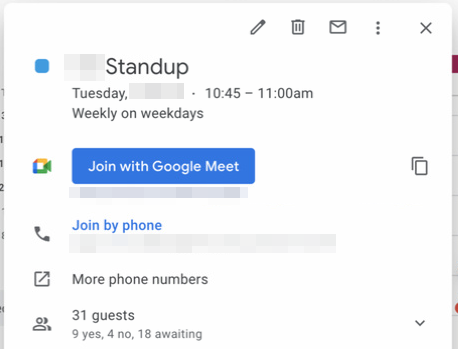How to run a worthless daily standup
Want to run a worthless daily? Invite 31 people. Ignore obstacles. Provide no accountability or feedback. Offer no focus. Don't promote team building or learning. Encourage people to zone out. And other great tips inside!A while back I got this meeting invitation:

15 minute meeting, 31 guests!
That’s just 29 seconds per person.
Before I relate the experience of actually attending that meeting, let’s consider the popular reasons for daily meetings. As Scrum is largely responsible for the popularity of this format meeting, let’s see what The Scrum Guide says:
Daily Scrums improve communications, identify impediments, promote quick decision-making, and consequently eliminate the need for other meetings.
But since this team wasn’t expressly using Scrum, let’s also consider other popular opinions about this staple of a meeting. Here are a few I found on Google:
- Identify and overcome obstacles to progress
- Increase accountability
- Maintain focus on the goal(s) of the team
- Community building and team unification
- Learning from each other
So how did this 31-person standup fare?
Well, to start, barely more than half of the invitees actually attended. But still, 17 people makes for a pretty crowded daily Zoom call!
Then the meeting chair went through a list of everyone in attendance and asked their status. A number of attendees responded by saying something like “Oh no, my Jira board is outdated. I’ll add a ticket for XYZ as soon as this meeting is over.”
The most concerning was the woman who said “I’m new, and I’m struggling to understand my task.” Ah-ha! An obstacle to overcome! So we’ll get someone to help her, right? “Okay, good luck!” was the response, and we moved on to the next person. 🤦♂️
And the icing on the cake: The last 5 minutes of this meeting was dedicated to the sprint “theme”, which for the time I was involved one developer providing a monologue about a favorite sporting event.
Now I don’t know the original purpose of this daily standup. But it didn’t appear to be serving any of the common purposes for a daily meeting. Obstacles were ignored. There was no accountability—people were editing their sprint tasks in an ad-hoc manner, with no feedback. There was no focus. There was no community building, and there was no learning. It was easy to tell by the frequent delayed response that most people were entirely zoned out of the meeting, just waiting for their name to be called so they could say something random until their turn was over.
If that’s not proof enough of the dysfunction of this meeting, after a week of these, one subset of 5 developers in this larger team decided to do their own post-daily daily, so they could actually discuss things relevant to them.




